As space exploration continues to evolve, the possibility of interplanetary colonization is becoming more feasible. Mars, in particular, has captured the attention of scientists and researchers as a potential site for human settlement. However, before we can establish a sustainable presence on the Red Planet, many technological challenges must be addressed.
From the harsh environment to the difficulties of space travel, the obstacles we face are numerous and complex. In order to overcome these challenges and pave the way for successful Mars exploration and colonization, we must continue to push the boundaries of innovation and collaboration.
In this article, we will explore the technological challenges of Mars colonization, from the complex environment to the challenges of propulsion and transportation systems, energy generation and storage, and robotics and automation. We will also address the importance of planetary protection and ethical considerations in our quest to establish a human presence on Mars.
Key Takeaways:
- The possibility of interplanetary colonization is becoming more feasible
- Before establishing a sustainable presence on Mars, technological challenges must be addressed
- Obstacles include the harsh environment, difficulties of space travel, and the need for innovative solutions in propulsion, energy generation, and robotics
- Planetary protection and ethical considerations are also crucial in Mars colonization efforts
The Significance of Mars Colonization
At the forefront of space exploration lies the ambitious goal of colonizing Mars. This is not only a tremendous feat of engineering and innovation, but also holds the potential of fundamentally transforming the future of space exploration and interplanetary colonization.
Mars colonization represents a critical step forward in our efforts to become a multi-planetary species. It is a crucial element in ensuring that our species can survive beyond the confines of Earth, and that we can continue to evolve and thrive in the vastness of space.
From a scientific perspective, Mars colonization presents an unparalleled opportunity to study and explore a planet in close proximity to our own. The Red Planet’s geological features, mineral resources, and potentially habitable environments make it an intriguing target for scientific discovery and investigation.
Moreover, Mars colonization holds enormous potential for resource utilization and economic development. The planet’s natural resources, such as water, minerals, and solar energy, could be harnessed to support not only future Mars colonists, but also Earth-based industries and enterprises.
Overall, Mars colonization represents a pivotal moment in the future of space exploration and interplanetary colonization. As we continue to push the boundaries of scientific discovery and innovation, we must work towards unlocking the full potential of this ambitious and groundbreaking mission.
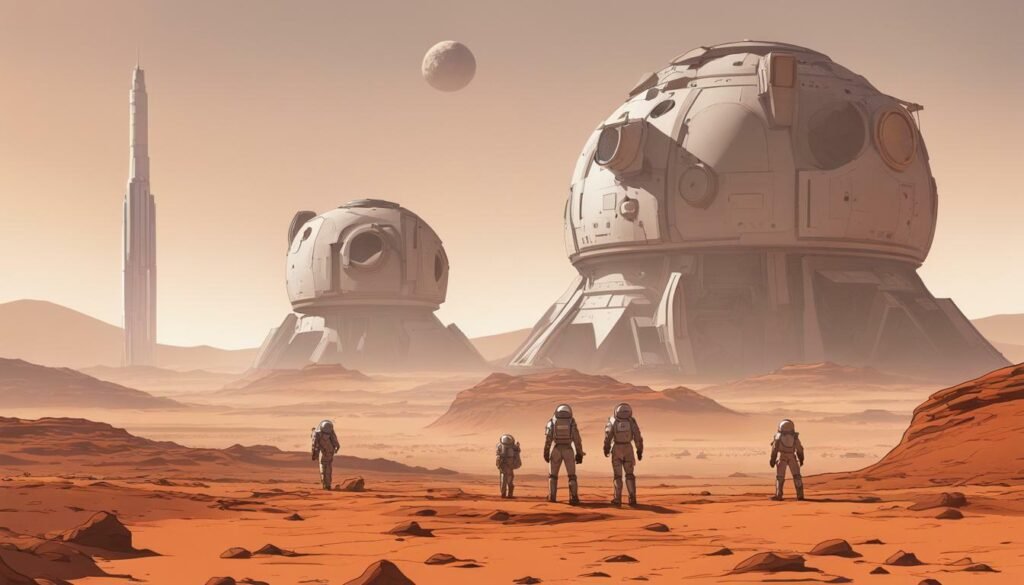
The Mars Environment: Key Challenges
As we prepare for Mars colonization, we must confront the unique technological challenges posed by the planet’s environment. Mars has a thin atmosphere with little protective shielding from solar radiation, extreme temperatures, and a lack of readily available resources.
One of the primary challenges of exploring Mars is providing a safe environment for human explorers. The thin atmosphere of Mars offers little protection from radiation exposure, which can have serious health consequences for astronauts. As we plan for Mars missions, we must develop technologies to shield astronauts from harmful radiation and minimize their exposure.
In addition to radiation exposure, the extreme temperatures on Mars can also pose a significant challenge for human habitation. Temperatures on Mars can vary from below -200°F to above 70°F, making it difficult to maintain a stable environment for human settlers. We must develop innovative technologies to regulate temperatures and protect human settlers from the harsh Mars environment.
Another significant challenge of Mars colonization is the lack of readily available resources. Unlike Earth, Mars does not have an abundance of water and other essential resources. In order to sustain human life on Mars, we must develop technologies to extract and purify water, as well as generate food and other vital resources.
Despite these challenges, we remain optimistic about the future of Mars exploration and colonization. Through continued research and innovation, we can develop the technologies necessary to overcome these challenges and establish a successful human presence on the Red Planet.
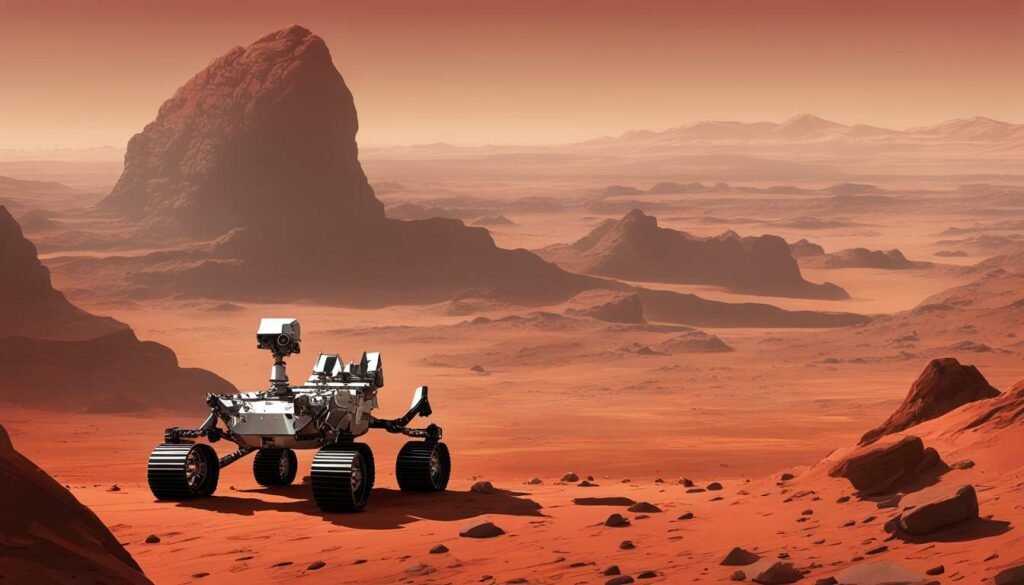
Propulsion and Transportation Systems
Developing propulsion and transportation systems that can safely and efficiently transport humans to and from Mars is one of the biggest challenges facing NASA and other space agencies involved in Mars exploration and colonization.
The current NASA mission, the Artemis program, aims to return humans to the moon by 2024 and establish sustainable exploration by 2028. This program will serve as a testing ground for the advanced propulsion and transportation technologies required to send humans to Mars.
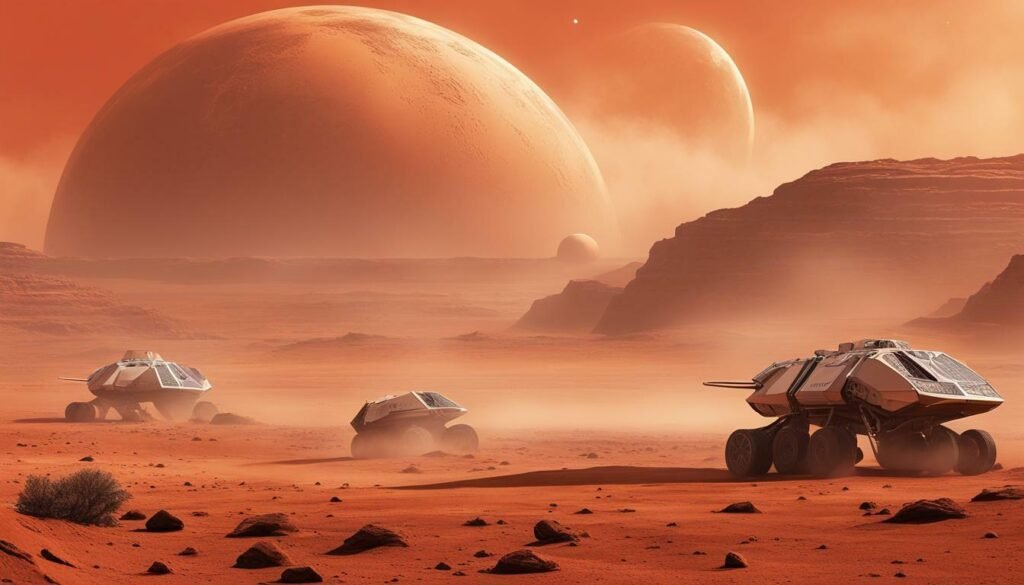
The Mars mission will require a powerful and efficient rocket capable of launching the spacecraft and crew into space. The spacecraft itself must be capable of providing a safe and comfortable environment for the crew during the long journey to Mars, while also carrying all necessary supplies and equipment for the mission.
One potential solution to reducing the overall cost and complexity of Mars missions is the development of reusable rockets and spacecraft. SpaceX’s Falcon 9 rocket and Crew Dragon spacecraft are examples of reusable space vehicles that can significantly reduce the cost of space travel.
Efficient propulsion systems are also crucial for successful Mars missions. Traditional chemical rockets are currently the most common propulsion technology used in space travel, but they are not efficient enough for interplanetary travel. NASA is exploring alternative propulsion technologies such as solar electric propulsion and nuclear thermal propulsion that could significantly shorten travel time and reduce mission costs.
Innovations in Propulsion Technology
One promising innovation in propulsion technology is the Variable Specific Impulse Magnetoplasma Rocket (VASIMR), which uses radio waves and magnetic fields to ionize and heat propellant, producing a plasma that generates thrust. This technology has the potential to drastically reduce travel time to Mars and other planets.
Another innovation in propulsion technology is the Ad Astra Rocket Company’s Advanced Space Propulsion Laboratory (ASPL), which is developing the Thruster for the Advancement of Low Temperature Operation (TALTO) engine. This engine uses superconducting magnets to generate high-thrust levels, making it ideal for deep space missions such as Mars exploration.
| Key Technologies: | Key Players: |
|---|---|
| Reusable rockets and spacecraft | SpaceX |
| Solar electric propulsion | NASA, Boeing, Lockheed Martin |
| Nuclear thermal propulsion | NASA |
| Variable Specific Impulse Magnetoplasma Rocket (VASIMR) | Ad Astra Rocket Company |
| Thruster for the Advancement of Low Temperature Operation (TALTO) engine | Ad Astra Rocket Company |
Developing and implementing these advanced propulsion and transportation technologies will be essential for future Mars missions and interplanetary colonization. We must continue to invest in research and development to overcome these technological challenges and pave the way for human exploration and settlement of new worlds.
The Mars Environment: Key Challenges
As we explore the possibility of Mars colonization, we must first address the challenges posed by the planet’s unique environment. The thin atmosphere of Mars means that human explorers will face extreme temperatures and a high level of radiation exposure. Additionally, the lack of readily available resources on the planet’s surface presents additional challenges.
To mitigate these challenges, innovative solutions are being developed to protect human explorers and ensure their survival on the Red Planet. For example, specialized radiation shielding materials and advanced life support systems will be necessary to provide breathable air, sustainable food and water sources, and protection from harmful radiation.
Another potential solution to the resource challenge is the use of in situ resource utilization (ISRU) technology. This involves extracting and utilizing local resources, such as water, ice, and minerals, for human needs. Current research is focused on developing the necessary technologies for this approach, including drilling systems, mining equipment, and processing systems.
Despite these challenges, we remain optimistic about the future of Mars exploration and colonization. The development of innovative technologies will allow us to overcome these obstacles and pave the way for a sustainable human presence on the Red Planet.
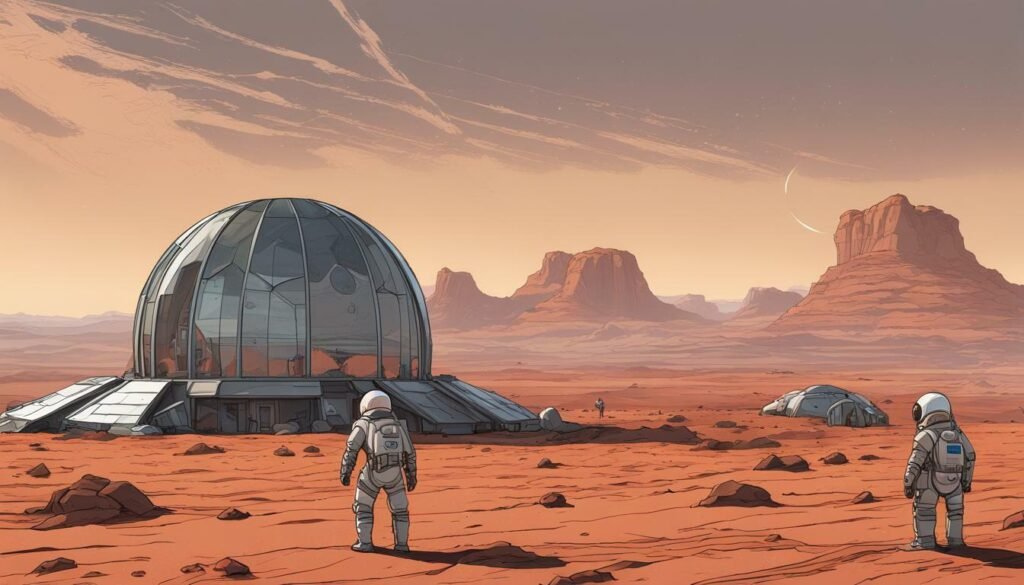
Communication and Navigation
Effective communication and navigation are critical components of successful Mars exploration and interplanetary colonization. As we embark on missions to Mars, we face significant challenges in establishing reliable communication networks and accurate navigation systems in the vast distances of space.
The communication delay between Earth and Mars can range from 4 to 24 minutes depending on the position of the planets in their respective orbits. This delay can significantly impact mission operations and decision-making processes. To mitigate this, we need to develop robust communication systems that can operate at high speeds and effectively transmit data over large distances. NASA’s Deep Space Network and other international collaborations are currently working to develop such systems.
Accurate navigation is also crucial to ensure safe and efficient travel to and from Mars. We need to develop advanced navigation technologies that can effectively guide spacecraft over long distances and account for the gravitational forces and orbital dynamics of two celestial bodies. NASA’s Mars Reconnaissance Orbiter and other missions have provided crucial data for developing these navigation systems.
As we continue to explore and colonize Mars, we must also work towards establishing a reliable and redundant communication and navigation infrastructure that can support future missions and ensure the safety of human explorers. Only then can we begin to unlock the full potential of interplanetary colonization.
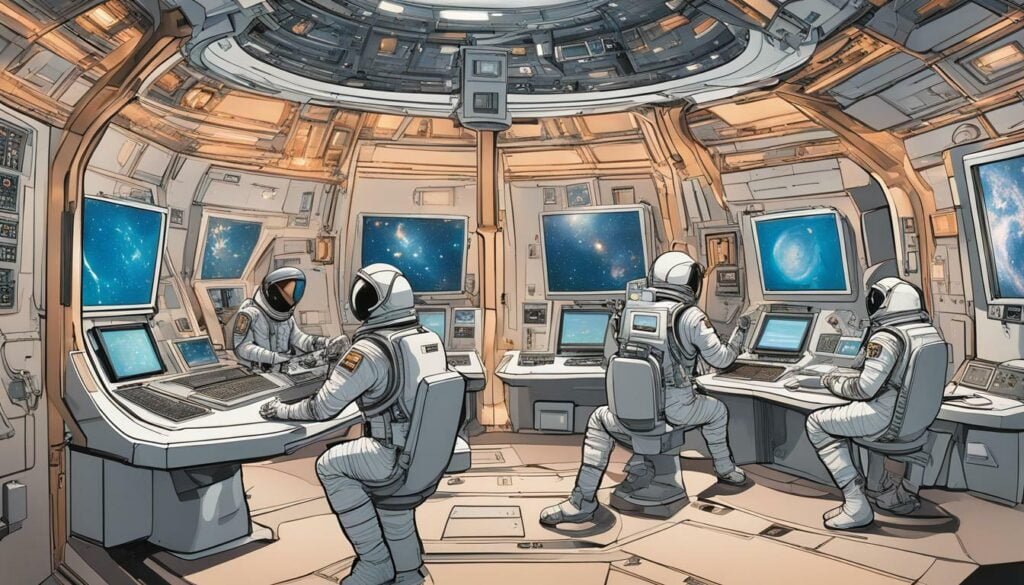
The Mars Environment: Key Challenges
As we prepare for the challenges of Mars colonization, we must first understand the specific technological hurdles posed by the harsh Martian environment. With its thin atmosphere, extreme temperatures, and high radiation exposure, human survival on Mars will require innovative solutions beyond what we have yet developed.
One of the key challenges is the Martian atmosphere, which is just 1% the density of Earth’s atmosphere. This means that any spacecraft entering the atmosphere will experience tremendous heat and friction due to the lack of air resistance. Additionally, the thin atmosphere provides little protection from solar radiation, exposing human explorers to higher levels of radiation than on Earth.
The extreme temperatures on Mars, with daytime temperatures reaching up to 70 degrees Fahrenheit at the equator, and nighttime temperatures dropping as low as -100 degrees Fahrenheit, also pose a significant challenge. Maintaining a stable temperature within habitats will be crucial to ensure human survival, as well as the reliable operation of equipment and infrastructure.
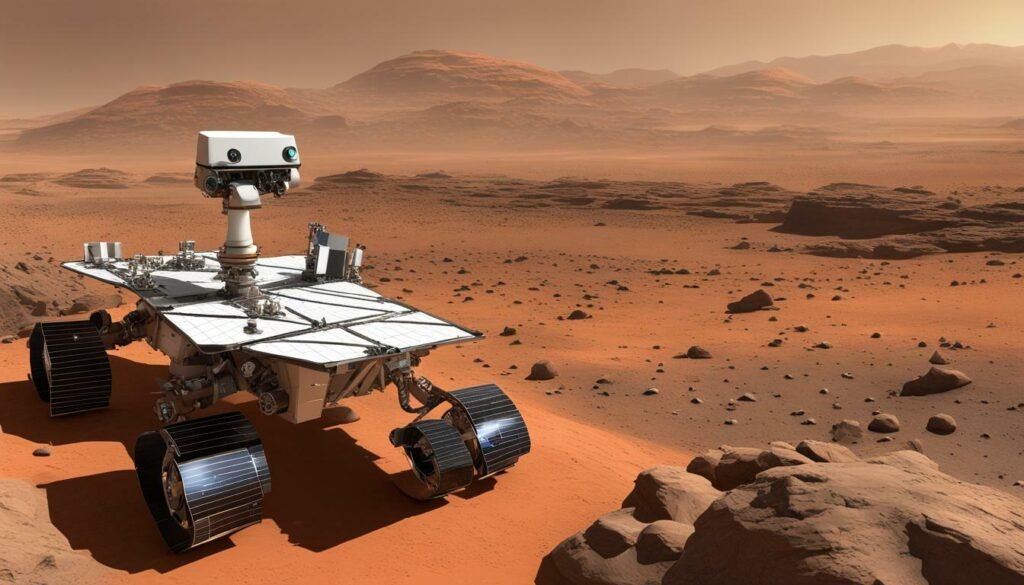
Furthermore, the lack of readily available resources on Mars, such as water and oxygen, presents a major challenge for human settlers. We must develop innovative technologies for resource extraction and utilization, such as extracting water from Martian soil or using plants to create a sustainable oxygen supply.
Overall, addressing the technological challenges posed by the Martian environment is essential for the success of any Mars mission and eventual colonization. We must continue to push the limits of scientific research and technological innovation to ensure the safety and sustainability of human explorers on the Red Planet.
Robotics and Automation
As we explore the challenges of Mars colonization, we recognize the significant role of robotics and automation. The harsh Martian environment presents numerous obstacles, including radiation exposure, extreme temperatures, and low atmospheric pressure, making it difficult and dangerous for human explorers.
Robotic systems offer a solution to many of these challenges, including resource extraction, construction, and maintenance. With the integration of artificial intelligence technologies, these systems can enhance mission efficiency, reduce human risk, and facilitate scientific research.
One example of robotic innovation for Mars exploration is NASA’s Mars 2020 rover, equipped with advanced scientific instruments and capable of collecting and storing samples for potential return to Earth. Additionally, private companies such as SpaceX are developing reusable rockets and spacecraft to enable more frequent and cost-effective access to Mars.
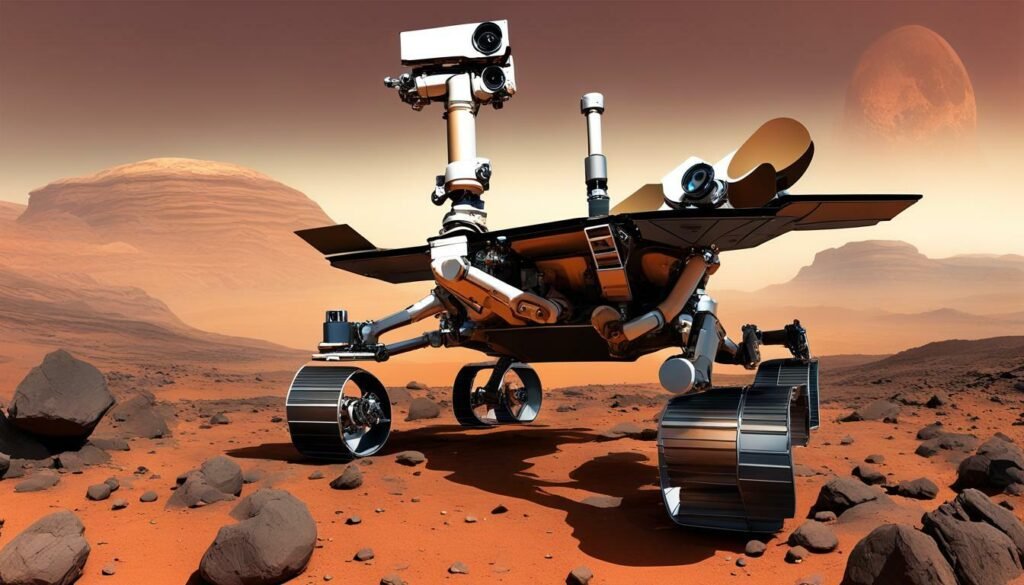
We recognize the important role of robotics and automation in the future of Mars exploration and colonization, and the need for continued research and development in this field to overcome the technological challenges inherent in space travel.
The Mars Environment: Key Challenges
When it comes to Mars colonization, the planet’s harsh environment presents significant technological challenges. The thin atmosphere poses risks to human health, while the extreme temperatures and radiation exposure make it difficult for humans to survive on the planet’s surface. Additionally, the lack of readily available resources on Mars means that settlers will have to rely heavily on technology to sustain themselves.
One of the biggest challenges of Mars colonization is protecting human explorers from the planet’s radiation. Mars lacks a protective magnetic field, which means that the surface is bombarded with high-energy particles from the sun. To protect against this radiation, technologies such as radiation shielding and protective suits will be necessary.
The planet’s thin atmosphere also presents challenges for Mars colonization. The atmospheric pressure on the surface of Mars is just 1% of Earth’s, making it impossible to breathe without a pressure suit. Additionally, the thin atmosphere means that there is little protection from the sun’s harmful UV rays, which can cause skin cancer and other health problems.
Another key challenge is the lack of readily available resources on Mars. Unlike Earth, Mars does not have a robust ecosystem that can support human life. This means that settlers will need to rely on technology to provide them with food, water, and other resources. Technologies such as greenhouse farming and water extraction from Martian soil will be crucial to Martian settlements.
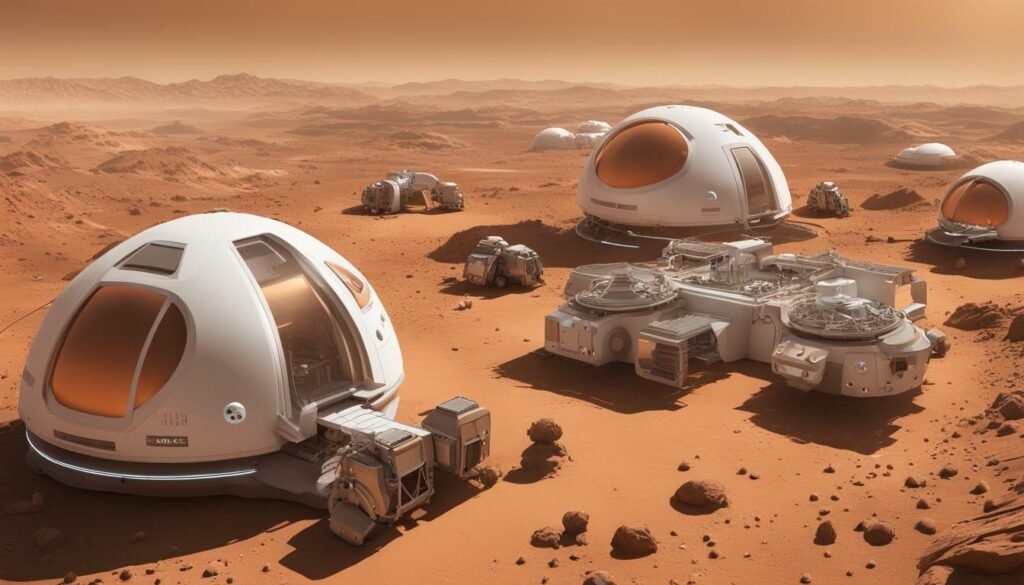
Addressing these challenges will be critical to the success of Mars colonization. Innovative solutions are needed to ensure that human explorers can survive on the Red Planet and thrive in a new interplanetary environment.
The Importance of Addressing Technological Challenges for Mars Colonization
As we embark on the mission to colonize Mars, we are faced with numerous technological challenges that must be overcome to ensure the success of the mission. From the harsh Mars environment to the need for advanced transportation and life support systems, the obstacles are numerous and complex.
However, these challenges must not deter us. The potential benefits of successful Mars colonization are immense, including groundbreaking scientific discoveries, new frontiers for exploration, and the establishment of a sustainable habitat for future generations.
It is vital that we address these challenges head-on, through continued research, innovation, and international collaboration. The recent success of NASA’s Mars mission has demonstrated that we have the capability to overcome some of these challenges, but there is still much work to be done.
Continued Research and Innovation
Research and innovation are key to overcoming the technological challenges of Mars colonization. We must continue to develop new technologies and systems that can operate in the harsh Mars environment, such as advanced propulsion systems, sustainable life support systems, and reliable communication networks.
Furthermore, we must invest in research to understand the Martian environment and its potential resources. This will enable us to develop technologies that can extract and utilize these resources, such as water and minerals, to support human settlements on the planet.
International Collaboration
International collaboration is also crucial to the success of Mars colonization. No single country or organization has all the resources and capabilities needed to tackle these challenges alone. By working together, we can pool our resources, knowledge, and expertise to achieve our common goal.
Moreover, international collaboration can help ensure that Mars colonization is conducted in an ethical and responsible manner. This includes establishing planetary protection measures to prevent contamination of Mars with Earth microbes, preserving the planet’s natural environment, and ensuring that any resource utilization is done in a sustainable and equitable way.
Conclusion
The challenges of Mars colonization are significant, but so too are the potential rewards. By addressing these challenges through continued research, innovation, and international collaboration, we can pave the way for successful and sustainable human settlements on the Red Planet.
As we continue to push the boundaries of space exploration, it is our duty to ensure that we do so with the utmost care and responsibility. By working together, we can make Mars colonization a reality and open up a new chapter in the history of human exploration and discovery.
FAQ
Q: What are the technological challenges of Mars colonization?
A: The technological challenges of Mars colonization include factors such as the thin atmosphere, extreme temperatures, radiation exposure, and the lack of readily available resources on Mars. Innovative solutions are needed to protect human explorers and ensure their survival on the Red Planet.
Q: Why is Mars colonization significant for the future of space exploration?
A: Mars colonization is significant for the future of space exploration because it offers potential benefits and opportunities such as scientific research, resource utilization, and the potential for multiplanetary civilization. Establishing a human presence on Mars could expand our understanding of the universe and pave the way for further space exploration.
Q: What advancements are needed in propulsion and transportation systems for Mars missions?
A: Successful Mars missions require advancements in propulsion and transportation systems. This includes the development of powerful rockets, efficient spacecraft, and innovative propulsion technologies that can enable safe and efficient travel to and from Mars.
Q: What challenges are posed by the Mars environment?
A: The Mars environment poses specific challenges such as the thin atmosphere, extreme temperatures, radiation exposure, and the lack of readily available resources. Addressing these challenges is crucial for ensuring the survival and well-being of human explorers on Mars.
Q: What are the key considerations for life support and habitability on Mars?
A: Life support and habitability on Mars require solutions for providing breathable air, sustainable food and water sources, and radiation shielding for human settlers. Various technologies are being developed to address these challenges and make Mars colonization feasible.
Q: Why is communication and navigation important in Mars exploration?
A: Communication and navigation are crucial in Mars exploration to establish reliable communication networks and accurate navigation systems. These systems are vital for supporting missions to Mars and ensuring efficient operations on the planet’s surface.
Q: What energy generation and storage systems are needed for Mars colonization?
A: Efficient energy generation and storage systems are essential for Mars colonization. This includes exploring the use of solar power, nuclear energy, and innovative energy storage technologies to meet the energy demands of human settlers on Mars.
Q: What role do robotics and automation play in Mars exploration and colonization?
A: Robotics and automation play a vital role in Mars exploration and colonization. Advanced robotic systems are needed for tasks such as resource extraction, construction, and maintenance, while artificial intelligence (AI) integration enhances mission efficiency and reduces human risk.
Q: What ethical considerations are associated with Mars colonization?
A: Ethical considerations of Mars colonization include the need to prevent contamination of Mars with Earth microbes and preserve the planet’s pristine environment. There are also ethical considerations regarding scientific research and the potential exploitation of Martian resources.
Q: What is the concluding message regarding Mars colonization?
A: In conclusion, addressing the technological challenges of Mars colonization requires continued research, innovation, and international collaboration. By overcoming these challenges, we can pave the way for successful Mars colonization and establish a sustainable human presence on the Red Planet, furthering our understanding of the universe.

